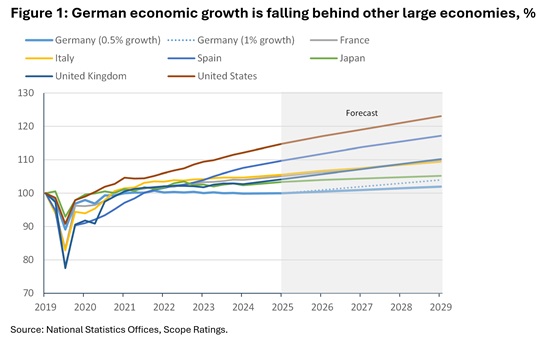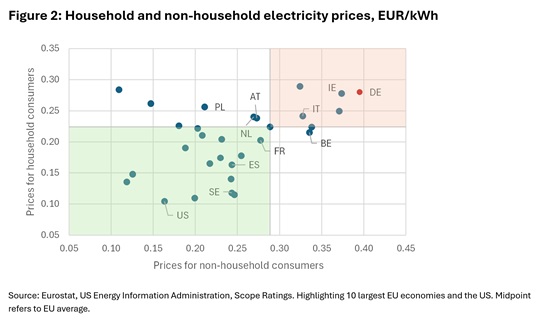Announcements
Drinks

Germany: industrial, labour, tax reforms essential to revive growth amid geopolitical challenges
By Eiko Sievert, Sovereign and Public Sector
The priority for a new government is to establish a clear industrial strategy, modernise Germany’s (AAA/Stable) energy infrastructure, and implement long overdue reforms in taxation, pension system and the labour market. Together, these measures would boost Germany’s economic competitiveness, raise the country’s growth outlook and address growing defence and welfare pressures.
Economy to stagnate in election year
After five years of near stagnation, the incoming government will have to prioritise boosting economic growth through supply-side reforms, not least because US protectionism adds to the geopolitical uncertainty challenging the German export-led growth model.
A broad-based increase in US import tariffs would significantly impact Germany’s automotive, machinery and equipment manufacturing industries. Such tariffs would lead to weaker export demand, higher input costs, and shrinking profit margins as companies adjust supply chains. In addition, even if tariffs are deferred or renegotiated, the persistent uncertainty is likely to curb investment over coming quarters.
We lowered our GDP forecast for 2025 to 0.1% from 0.9% to account for the likely impact of US tariffs and the collapse of Germany’s coalition government in November, which delays potential fiscal stimulus.
German GDP growth has lagged other major European economies (Figure 1). Since 2019, GDP expansion in Spain (+8%), Italy (+5%), France (+4%) and the UK (+3%) has outpaced that of Germany as have growth rates in Japan (+2%) and the US (+12%). With demographic pressures mounting, we estimate the country’s medium-term growth potential at around 0.5-0.7%.

Germany’s weak growth outlook reflects its declining international competitiveness, dropping from 15th place in 2022 to 24th in 2024 in the IMD World Competitive Ranking. However, there are several ambitious reforms the next coalition government could undertake after the 23 February elections to tackle Germany’s structural challenges.
Need to address high energy prices
Access to cheap energy has been crucial for Germany’s industrial base. However, after post-pandemic price surges, EU natural gas prices in 2024 remained approximately five times as high as in the US. This compares with prices being approximately 1.8x US prices in 2019.
One way to address Germany’s high energy costs is through greater investment in power infrastructure to better integrate growing volumes of intermittent solar- and wind-powered electricity. However, relying primarily on private sector commitments will keep German electricity prices among the highest in the EU (Figure 2) as firms pass costs to end-users.
The significant investment needs for the energy transition are likely to keep electricity prices in Germany elevated compared with other EU countries. Still, the new government could consider reducing taxes on electricity and shifting part of the cost for upgrading the grid to the public sector. Such measures could be possible within the existing debt brake framework, if structured as a financial transaction.
Competitive tax regime and labour market reforms to encourage private investment
A more competitive personal and corporate tax regime could help raise private-sector investment and narrow Germany’s large investment gap, which we estimate at more than EUR 400bn compared to other AAA-rated sovereigns.
Germany’s corporate tax rate is high at 29.9%, above Italy (27.8%), France (25.8%), the US (25.6%) and the UK and Spain (both 25%). Similarly, the tax wedge – measuring the difference between an employee's total labour cost to their employer and the net take-home pay – is one of the highest among developed economies.
In addition, greater investment in education and labour market reforms could enable higher workforce participation among women and migrants. Given Germany’s ongoing shortage of skilled workers, reforms to encourage the older generation to work after retirement would support labour supply and ease fiscal pressures stemming from Germany’s demographic challenge.
Reducing bureaucracy and simplifying regulation to support private sector investment has been recognised as a priority by most political parties, although any implementation of reforms will likely be gradual.
These structural reforms are still critical to raise the country’s medium-term growth. Combined with a potential reform of the debt-brake rule to allow for more growth-enhancing public-sector investment, this would create additional fiscal space to help address rising expenditure needs while ensuring long term economic resilience.
Rising defence and continuous welfare pressures
Germany currently meets NATO’s 2% of GDP military spending target thanks to a EUR 100bn special fund agreed in 2022. Most of this fund has already been allocated to various defence expenditure. However, from 2027, an additional EUR 30bn a year will be needed, requiring higher government revenues, spending cuts or new debt issuance.
In 2024, defence spending accounted for 11% of the federal budget. Without additional revenue sources, this share would have to rise to around 18% to meet the current NATO target. If NATO members were to increase the target to 3% of GDP, then 27% of the current budget would have to be allocated to defence spending.
At the same time, none of the larger political parties has proposed meaningful reforms to address Germany’s rising pension burden – proposals that are unpopular in election campaigns, but crucial for long-term fiscal stability. Around 27% of the total 2025 budget will be spent on pensions and this share could double by 2050 with the old age dependency ratio rising to more than 50% from 36% today.
Be sure to join us for our webinar on Wednesday, 26 February at 11:00 CET: Is Germany at an inflection point? Post-election implications.






